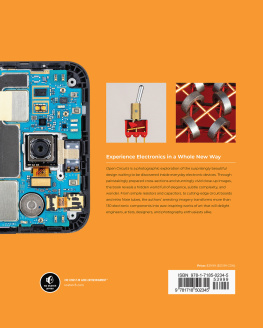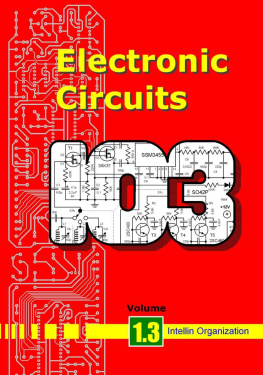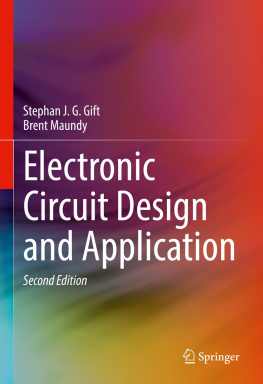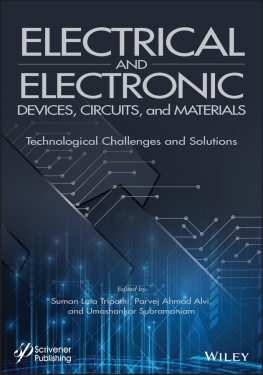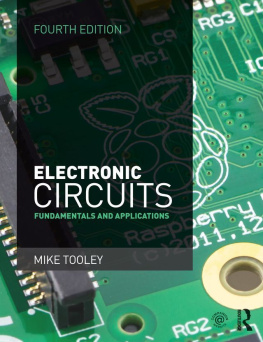Won Y. Yang - Electronic Circuits with MATLAB, PSpice, and Smith Chart
Here you can read online Won Y. Yang - Electronic Circuits with MATLAB, PSpice, and Smith Chart full text of the book (entire story) in english for free. Download pdf and epub, get meaning, cover and reviews about this ebook. year: 2020, publisher: Wiley, genre: Home and family. Description of the work, (preface) as well as reviews are available. Best literature library LitArk.com created for fans of good reading and offers a wide selection of genres:
Romance novel
Science fiction
Adventure
Detective
Science
History
Home and family
Prose
Art
Politics
Computer
Non-fiction
Religion
Business
Children
Humor
Choose a favorite category and find really read worthwhile books. Enjoy immersion in the world of imagination, feel the emotions of the characters or learn something new for yourself, make an fascinating discovery.
- Book:Electronic Circuits with MATLAB, PSpice, and Smith Chart
- Author:
- Publisher:Wiley
- Genre:
- Year:2020
- Rating:5 / 5
- Favourites:Add to favourites
- Your mark:
- 100
- 1
- 2
- 3
- 4
- 5
Electronic Circuits with MATLAB, PSpice, and Smith Chart: summary, description and annotation
We offer to read an annotation, description, summary or preface (depends on what the author of the book "Electronic Circuits with MATLAB, PSpice, and Smith Chart" wrote himself). If you haven't found the necessary information about the book — write in the comments, we will try to find it.
Won Y. Yang: author's other books
Who wrote Electronic Circuits with MATLAB, PSpice, and Smith Chart? Find out the surname, the name of the author of the book and a list of all author's works by series.
Electronic Circuits with MATLAB, PSpice, and Smith Chart — read online for free the complete book (whole text) full work
Below is the text of the book, divided by pages. System saving the place of the last page read, allows you to conveniently read the book "Electronic Circuits with MATLAB, PSpice, and Smith Chart" online for free, without having to search again every time where you left off. Put a bookmark, and you can go to the page where you finished reading at any time.
Font size:
Interval:
Bookmark:

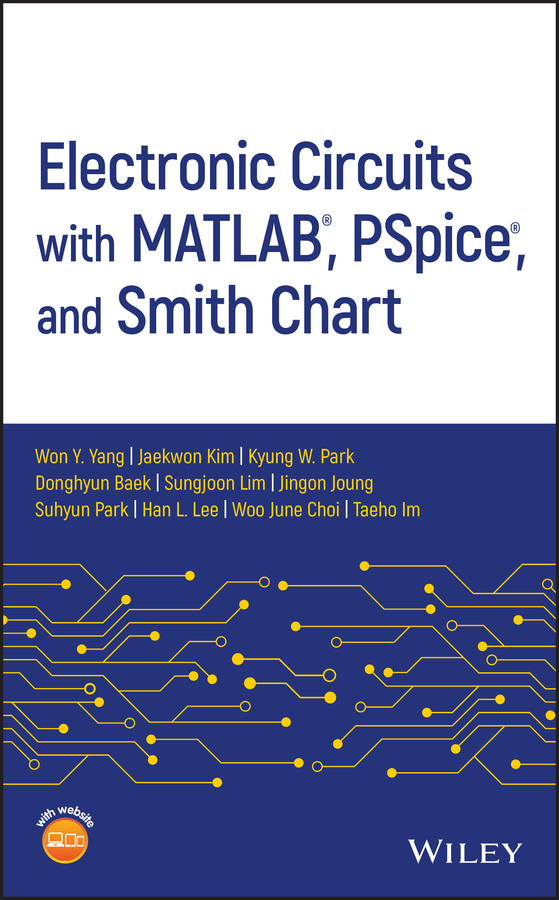
- Chapter 1
- Chapter 3
- Chapter 4
- Chapter 5
- Chapter 6
- Chapter 8
- Appendix A
- Appendix G
- Appendix H
- Appendix I
- Appendix J
- Chapter 1
- Chapter 2
- Chapter 3
- Chapter 4
- Chapter 5
- Chapter 6
- Chapter 7
- Chapter 8
- Appendix A
- Appendix G
- Appendix H
- Appendix I
- Appendix J
Won Y. Yang, Jaekwon Kim, Kyung W. Park, Donghyun Baek, Sungjoon Lim, Jingon Joung, Suhyun Park, Han L. Lee, Woo June Choi, and Taeho Im

This edition first published 2020
2020 John Wiley & Sons, Inc.
All rights reserved. No part of this publication may be reproduced, stored in a retrieval system, or transmitted, in any form or by any means, electronic, mechanical, photocopying, recording or otherwise, except as permitted by law. Advice on how to obtain permission to reuse material from this title is available at http://www.wiley.com/go/permissions.
The right of Won Y. Yang, Jaekwon Kim, Kyung W. Park, Donghyun Baek, Sungjoon Lim, Jingon Joung, Suhyun Park, Han L. Lee, Woo June Choi, and Taeho Im be identified as the authors of this work has been asserted in accordance with law.
Registered Office
John Wiley & Sons, Inc., 111 River Street, Hoboken, NJ 07030, USA
Editorial Office
111 River Street, Hoboken, NJ 07030, USA
For details of our global editorial offices, customer services, and more information about Wiley products visit us at www.wiley.com.
Wiley also publishes its books in a variety of electronic formats and by printondemand. Some content that appears in standard print versions of this book may not be available in other formats.
Limit of Liability/Disclaimer of Warranty
MATLAB is a trademark of The MathWorks, Inc. and is used with permission. The MathWorks does not warrant the accuracy of the text or exercises in this book. This work's use or discussion of MATLAB software or related products does not constitute endorsement or sponsorship by The MathWorks of a particular pedagogical approach or particular use of the MATLAB software. While the publisher and authors have used their best efforts in preparing this work, they make no representations or warranties with respect to the accuracy or completeness of the contents of this work and specifically disclaim all warranties, including without limitation any implied warranties of merchantability or fitness for a particular purpose. No warranty may be created or extended by sales representatives, written sales materials or promotional statements for this work. The fact that an organization, website, or product is referred to in this work as a citation and/or potential source of further information does not mean that the publisher and authors endorse the information or services the organization, website, or product may provide or recommendations it may make. This work is sold with the understanding that the publisher is not engaged in rendering professional services. The advice and strategies contained herein may not be suitable for your situation. You should consult with a specialist where appropriate. Further, readers should be aware that websites listed in this work may have changed or disappeared between when this work was written and when it is read. Neither the publisher nor authors shall be liable for any loss of profit or any other commercial damages, including but not limited to special, incidental, consequential, or other damages.
Library of Congress CataloginginPublication data applied for
ISBN: 9781119598923
Cover design: Wiley
Cover image: green_01/Shutterstock
To our parents and families
who love and support us
and
to our teachers and students
who enriched our knowledge
The aim of this book is not to let the readers drowned into a sea of computations. More hopefully, it aims to inspire the readers with mind and strength to make full use of the MATLAB and PSpice softwares so that they can feel comfortable with mathematical equations without caring about how to solve them and further can enjoy developing their ability to analyze/design electronic circuits. It aims also to present the readers with a steppingstone to radio frequency (RF) circuit design from juniorsenior level to seniorgraduate level by demonstrating how MATLAB can be used for the design and implementation of microstrip filters. The features of this book can be summarized as follows:
- For representative examples of designing/analyzing electronic circuits, the analytical solutions are presented together with the results of MATLAB design and analysis (based on the theory) and PSpice simulation (similar to the experiment) in the form of trinity. This approach gives the readers not only information about the state of the art, but also confidence in the legitimacy of the solution as long as the solutions obtained by using the two software tools agree with each other.
- For representative examples of impedance matching and filter design, the solution using MATLAB and that using Smith chart have been presented for comparison/crosscheck. This approach is expected to give the readers not only confidence in the legitimacy of the solution, but also deeper understanding of the solution.
- The purposes of the two softwares, MATLAB and PSpice, seem to be overlapped and it is partly true. However, they can be differentiated since MATLAB is mainly used to design circuits and perform a preliminary analysis of (designed) circuits while PSpice is mainly used for detailed and almost realworld simulation of (designed) circuits.
- Especially, it presents how to use MATLAB and PSpice not only for designing/analyzing electronic and RF circuits but also for understanding the underlying processes and related equations without having to struggle with timeconsuming/errorprone computations.
The contents of this book are derived from the works of many (known or unknown) great scientists, scholars, and researchers, all of whom are deeply appreciated. We would like to thank the reviewers for their valuable comments and suggestions, which contribute to enriching this book.
We also thank the people of the School of Electronic and Electrical Engineering, ChungAng University for giving us an academic environment. Without affections and supports of our families and friends, this book could not be written. We gratefully acknowledge the editorial, Brett Kurzman and production staff of John Wiley & Sons, Inc. including Project Editor Antony Sami and Production Editor Viniprammia Premkumar for their kind, efficient, and encouraging guide.
Program files can be downloaded from https://wyyang53.wixsite.com/mysite/publications. Any questions, comments, and suggestions regarding this book are welcome and they should be mailed to wyyang53@hanmail.net.
Won Y. Yang et al.
Do not forget to visit the companion website for this book:
Font size:
Interval:
Bookmark:
Similar books «Electronic Circuits with MATLAB, PSpice, and Smith Chart»
Look at similar books to Electronic Circuits with MATLAB, PSpice, and Smith Chart. We have selected literature similar in name and meaning in the hope of providing readers with more options to find new, interesting, not yet read works.
Discussion, reviews of the book Electronic Circuits with MATLAB, PSpice, and Smith Chart and just readers' own opinions. Leave your comments, write what you think about the work, its meaning or the main characters. Specify what exactly you liked and what you didn't like, and why you think so.


